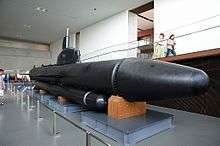Kairyū-class submarine
The Kairyu (海龍, Kairyū, "Sea Dragon") was a class of midget submarines of the Imperial Japanese Navy, designed in 1943–1944, and produced from the beginning of 1945. These submarines were meant to meet the invading American naval forces upon their anticipated approach of Tokyo.
 A Kairyu "Sea Dragon" in the Aburatsubo inlet. | |
| Class overview | |
|---|---|
| Operators: |
|
| Planned: | 760 |
| Completed: | 200–213 (sources vary) |
| Active: | 0 |
| General characteristics | |
| Type: | Kairyu (海龍 "Sea Dragon") class midget submarine |
| Displacement: | 19.3 t (21.3 short tons) |
| Length: | 17.2 m (56 ft 5 in) |
| Beam: | 1.3 m (4 ft 3 in) |
| Height: | 1.3 m (4 ft 3 in) |
| Propulsion: |
|
| Speed: |
|
| Range: |
|
| Complement: | 2 |
| Armament: | 2 × 450mm torpedoes and a 600 kg (1,300 lb) explosive charge |
History

More than 750 of these submarines were planned and by August 1945 about 210 had been manufactured. Most of them were constructed at the Yokosuka shipyard. These submarines had a two-man crew and were fitted with two torpedoes along with a 600 kg (1,300 lb) explosive charge intended to be used on a suicide mission.
Most of the Kairyu submarines were based at Yokosuka to defend the entrance of Tokyo Bay in the event of a United States invasion of mainland Japan. Some of these subs were also stationed in the Moroiso and Aburatsubo inlets on the southern tip of the Miura Peninsula where a training school had also been set up.
Due to Japan's surrender on August 1945, after the atomic bombings of Nagasaki and Hiroshima, none of these submarines ever saw action.
Technical details

All modifications of the Kairyu class are constructed from 3 sections of welded steel bolted together. The sections are the fore (warhead), mid (diesel engine, ballast, fuel, controls and batteries) and finally the aft (motor and control planes).
The bow section can be installed with or without a warhead.
Following on from the bow is the central section, first in this section are the batteries for the electric motor and the air flasks. Then is the pilot area. He has numerous controls including controls for the fore and aft dive planes and rudders, valves for oil, fuel and water and the periscope raise/lower controls. Behind the pilot are the main ballast tank and fuel tank.
Abaft the fuel tank and ballast tank is the in-line six diesel engine, followed by the aft trim tanks, gearbox and reduction motors and finally the electric motor and propellers.
In the conning tower there is usually a Type 4 magnetic compass however in some early models there is a Type 97 gyrocompass in the boat itself.[2]
Modification 3
While both the original and second modifications were practically identical, the third modification of the class had some notable differences.
The overall length is 160 cm (63 in) longer. The forward dive planes have been moved forward of the conning tower. There is no external magnetic compass and the fuel tank is now installed before the pilots control area. There is also a second periscope aft of the conning tower.
This model could very well have been used for training purposes with a complement of 3.
Survivor
A Kairyū-class submarine, cutaway to show interior details, is on display at the US Navy Submarine School at Naval Submarine Base New London in Groton, Connecticut. It has been there since at least the mid-1960s.
References
- Rekishi Gunzo, p. 119.
External links
| Wikimedia Commons has media related to Kairyu class submarine. |